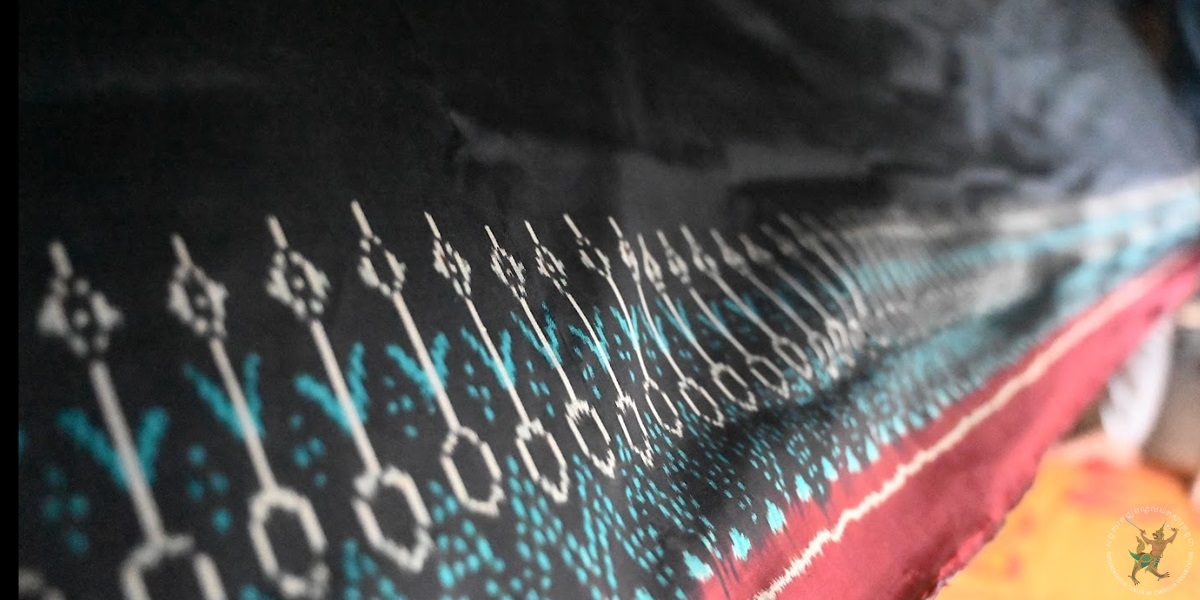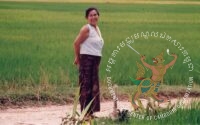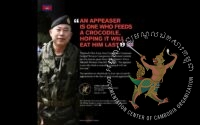“Color of Memory” Project Gives Hope to Cham Silk Weavers

(Kampong Cham): The Cham community has been weaving silk for a long period of time and is known for their colorful tradition and identity. In the present moment, only a few Chams continue to weave as a part of their daily lives that could generate an additional income for supporting their family. Cham silk was fashionable and popular before and after the Khmer Rouge era, but now facing low demand, some of them decided to stop weaving, Cham Silk is on the edge of disappearance. Nowadays, the next generation of Chams are not interested in continuing their family traditions due to low payment. At risk of disappearing, the Turkish Cooperation and Coordination Agency (TIKA) and the Documentation Center of Cambodia (DC-CAM) are trying to support and promote the Cham silk under the “Colors of Memory” project.
The Cham silk weavers have shown renewed hope in silk weaving after the start of this project. However, they remain concerned about the disappearance of the Cham silk, which reflects the culture and identity of the Cham ethnic community. Kob Kha-Ches, 58, has been a weaver for about 20 years. She lives alone while her single child is working in a factory in Phnom Penh. She is waiting for the demand from the market, so she generates income from this silk weaving to support her daily life. Sitting in front of her house in Koh Sotin commune, Koh Sotin district, Kampong Cham province, she told D News, “I have been weaving for about 20 years already. I only know how to weave and have been weaving since the 90s [1990]. I do not know how to fish, I do not know how to ride a bike, I do not know how to ride a motorcycle. [I] only stay in one place.” She learned how to weave from her parents and said that her parents had a silk business distributing directly to the market, not as a commission weaver as she is today.
Unfortunately, for the present moment the Cham silk was disappearing after the Khmer Rouge regime due to the genocide on Cham community including her parents who also lost their lives during that period. She described, “The flowers (style) are tied to inkle loom; we tie them with our hands according to what we could remember and experience as the beginning. When we remember those flowers, we tie them. There is no pattern, do it from our heart, our brain is always thinking and trying to remember, we have been doing it for a long time.” Two years after the Khmer Rouge regime, she started weaving again, remembering how her parents made it. She said that at that time she was struggling because she did not have the money to start the silk business because silk was expensive and cost a lot of money for production.
Currently, she complains that the income from weaving is not enough to support her daily life. She said, “Not enough, it takes a long time to weave, until we get a Kben (3-4 meters of the skirts), then we spin, and it is not as fast as young people. Young people, they are fast. It consumes a lot of time over a half month for a Kben, not enough for spending on daily life. [I] Live depend on weaving while my child supports me with some money.” She continued, “Young people now don’t like weaving due to low income and it takes a long time and commitment to make money. So, for them, fishing could earn more, and it makes money easily… Only old people like me that still weaving.” She had some hope after the “Colors of Memory” project and said, “If this organization [Documentation Center of Cambodia] continues to support, we can weave, like to tie flowers (style) or to tie another thing that represent our Chams identity.”
Kob Mary, 35, is also a silk weaver in Koh Sotin commune, Koh Sotin district, Kampong Cham province. She has three children and now she weaves silk after fishing and selling fish at the local market. She told D-News that she had been pausing weaving for more than 10 years and had only been back for two months after the demand through the organization’s support. She started weaving silk at the age of 17. She learned to weave from her mother. Sitting on the loom, Mary said, “They stopped because no customer”. Starting over two months ago, she described that the income from weaving also eased her financial burden for a while. She continued, “After work at home, as it is easy at home, we do not have go anywhere, we just sit and weave, and we can go to sell fish in the morning. We weave to help our livelihood.” When she was young, she started weaving, and she said that there were silk weavers in almost every house. If a house has 2-3 daughters, they can weave 2-3 looms, but now because there are not many customers, there are not as many weavers as before. However, weavers who used to weave are still waiting to silk weaving if customers need it.
Min Sanas, project manager of “Colors of Memory” at the Documentation Center of Cambodia (DC-Cam), told D-News that her team met with Chams, the Khmer Rouge survivors to ask about each Koum and specific color before deciding on a Koum and color for this project. The Koum (a flower style on the Cham Silk) and color (specific color style) of the skirt will reflect and recall from the colors and Koum through the memories of the survivors. Sanas described, “The skirts woven in present is black because of the Popularity Socialist Community period [Sangkum Reast Niyum] or before the Khmer Rouge regime, the Cham people like to wear black clothes, but in the Khmer Rouge regime, because the Khmer Rouge required people to wear only black clothes, this also scares Cham people, as they stopped wearing black, they weaved into different colors, but now DC-Cam is making black skirts as the reflection of the tradition of Cham and as memorial or memories of survivors of the Khmer Rouge regime.”
The project aims to preserve the Cham silk over the use of colors and Koum through the memories of Khmer Rouge survivors, and to generate stable income through Cham silk weaving, this is also for supporting the community and inspiring the Cham youths to pay attention on their tradition and identity. In addition, the project also aims to remind and recognize this Cham silk weaving, both domestically and internationally. Kha-Ches proposes to the government to support and find the market for Cham silk weaving so that she can earn a living from weaving. “We are weaving for commissions, so if we have our own business, we suggest the government find a market for us, so we could keep this tradition weaving skill,” she suggested.
Text by Bean Seynak
Translated by D-News
October 3, 2023




